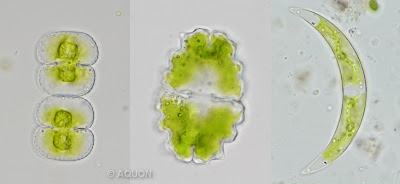In March and
May 2012 we sampled Voormeer of the fen Groote Meer at the Kalmhoutse Heide
Woensdrecht, Province of Noord-Brabant, the Netherlands. Groote Meer is a very
sensitive area of the Brabantse Wal. The sampling is part of a pilot project of
AQUON for one of the Dutch Water Boards to learn about the desmid cultures
of the fen. The desmids relate to the water quality of the different small
habitats of the fen, called microhabitats.
In March we
started with a very bright sunshiny day and in May the rain cover was threatening,
though not persistent. Eventually we had a very warm day at the fen. In March
we saw a lot of frog spawn and in May the frogs were singing loudly, warming up
in the mud on this dazzling Spring day.
 |
| A big green frog warming up on the sand. |
We sampled
the vegetation, the open water and the wet soil close to the water surface. The
fen is a kind of an ambiguity ranging from mesotrophic water to eutrophic water.
This is a result of the different
influences of water canals from agriculture, and the connection between Voormeer and Achtermeer of the Groote Meer as a whole.
.jpg) |
| Map of Groote Meer with Voormeer and Achtermeer. The red and yellow dots represent the sampling locations. Reference: AMT Joosten. |
During the
hot Summer days the fen will dry up naturally. The black-necked grebe and the
little grebe live and breed here while the fen is still wet in Spring. Various forms of vegetation can be found, near
the water and in the water, like crystalwort and marsh club moss.
 |
| Crystalwort at Voormeer |
The habitat
of the Groote Meer varies greatly if you go from North-West to South-East. The fen is
mainly fed by rainwater (weakly buffered). It’s one of the biggest fens located
in the Netherlands. Due to the vulnerability and preciousness of the Brabantse
Wal, the area is included in the European network project of Natura 2000.
 |
| Habitat Voormeer South-West |
In March and in May we covered ground, all around the Voormeer and we took samples which eventually seemed not yet so rich in desmids. Though we did find interesting species: species which are not known from the Netherlands and species which are quite selective.
 |
| Habitat Voormeer South-East |
We still need to determine some of the species,
analyze the abundance and conclude the
Ecological Quality Ratio (EQR). EQR is a method to quantify the values of the
species found in relation to water quality. The deadline of the pilot project
is January 2013, so I will have plenty of preparation time for the ecological
report on the desmids of the Groote Meer.
 |
| Me sampling the East-side of Voormeer. Photograph by W.Bolkenbaas. |
Below you will find the first results of the pre-analysis by light-microscopy research of live samples.
 |
| From left to right: Cosmarium pesudoornatum after cell division, Euastrum bidentatum var. bidentatum and Closterium incurvum. |
 |
| From left to right: cf. Roya anglica var. montana - we need to investigate further with electron microscopy, and Staurodesmus extensus. |
